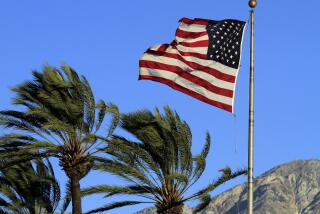Discovering the Science and Soul of Breezes and Gales
- Share via
In one of the myths of the Abenaki people, trickster is hunting ducks, but a terrible wind is blowing. He decides he has to stop it and walks headlong into the gale. Stripped of his clothes and finally his hair, he comes to a mountain peak and discovers an eagle, the cause of his trouble.
Trickster ties up the enormous bird, and the wind stops, a grand but terrible mistake, yet a perfect gloss for the stories that make up “Wind,” Jan DeBlieu’s epic account of mankind’s long walk into the zephyrs, williwaws, Chinooks and tornadoes that have ever coursed across the Earth.
It begins simply enough, DeBlieu writes: “A subtle stirring caused by the sunlight falling on the vapors that swaddle the Earth . . . [which] begin to swirl as if trapped in a simmering caldron. . . . Tumbling together, the particles of air become a huge, unstoppable current.”
But just consider the havoc these particles have played: the Ice Age, the Mississippi flood of 1993, the defeat of Xerxes at Salamis, the 1961 All Star Game (Stu Miller was blown off the mound during his windup), the attempt to rescue the American hostages in Iran.
Myth and religion, meteorology and geology, sociology and politics--and the story of her own obsession with these unstoppable currents--”Wind” is a maelstrom of the science, poetry and people who just can’t seem to get in from the storm.
Sit for a moment in a duck blind with hunters who, unlike our trickster, have discovered a wind funnel that brings birds right to them. Or ride in a biplane in 1926 above Louisiana with an entomologist intent upon capturing all the bugs that have drifted into the air.
Listen to the balloonists, airline pilots, wind surfers, the hang gliders and engineers, and you’ll soon find yourself immersed in the definitive book, which is both its virtue and fault. The complete story of wind needs some breeziness, but DeBlieu’s interviews and accounts feel almost dutiful and still.
She is at her best when she writes without the experts beside her. When she lays out a picture of the global wind system, it’s a stunning view of the Earth from space. “ . . . begin at the equator, where air warmed by intense solar radiation rises and moves toward the poles. Surface winds, caught in a vacuum created by the rising air, rush toward the equator . . . but are turned westward by the force of the Earth’s spin.”
As good as she is with the big picture, she handles the smaller details with equal skill. Once again, she leaves the experts behind, and for a moment climbs a sand dune at Run Hill, N.C. Once a spectacular ocean of moving sand, this landmark is slowly disappearing, leaving her to tread the line between environmentalism and nostalgia. “Cascading sand buries my feet and shins; I have to scramble hard to break free. On top now, I squint west across the platinum surface, using my hand to shield my eyes. . . . Should we freeze the dune in time by grassing it over?”
Writing as much about the wind as about her impressions of the wind, DeBlieu personalizes the story, but her sentimentality (“Wind comforts us and challenges us and feeds us, physically and spiritually. It helps power the engine of life.”) spoils her more precise observation. But clearly science can only say so much about the salutary effect of a cool breeze on a hot day or the edginess brought on by down slope winds such as a Santa Ana.
In the day and age of the weather channel, when El Nin~o and La Nin~a are as familiar as Barney, “Wind” will strike a popular chord, just right for nights when our own quiet world is transformed by the wind and meek little housewives feel the edge of carving knives and start to study their husbands’ unsuspecting necks.
More to Read
Sign up for our Book Club newsletter
Get the latest news, events and more from the Los Angeles Times Book Club, and help us get L.A. reading and talking.
You may occasionally receive promotional content from the Los Angeles Times.









